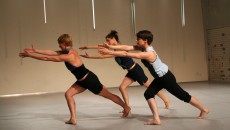By Mara Nedelcu
At its 25th edition this year, Tanz im August prepared an anniversary program for the contemporary dance audience in Berlin. Bettina Mauch, this year’s artistic director, presents a set of reflections on the passing of time. The mark left behind by time is understood and addressed both by the curator and the invited artists from very different perspectives, offering the viewer an exciting and dynamic experience for two weeks (August 15 – 31) in the company of ‘older’ or ‘newer’ contemporary dance.
The highlight of the program are the well-known American choreographers Trisha Brown and Steve Paxton, invited to present their earlier works. Bettina Mauch dives into the history of dance and presents to the contemporary dance audience two iconic figures of the New York postmodern dance scene. Trisha Brown presents works from the ‘70s, choreographic moments in which the body is displayed as a kinetic sculpture, in the specific minimalist style of a period marked by formalism, abstractionism and the white cube. Steve Paxton reenacts a solo created 30 years before. The postmodern American generation stands out through the struggle for equality and democracy, while Paxton declares an equality between the dancer’s body and all the other objects on stage.
The social and political historical dimension is approached by the Congolese choreographer Faustin Linyekula in Drums and Digging. His work brings forth a journey in search of a creative inspiration in the context of the dictatorial regime in his native country, between the chaos and urban ruins in Gbadolite and the African ancestral village.
The Brazilian choreographer Bruno Beltrão seeks, on the contrary, to free the body from the influences of the affective memory and bring it in an absolute time of the contemporary determined by information technology. His choreographic material from humanity’s repertoire of gesture does not seek to trace aesthetic directions or a certain style, but is inspired from a random repertoire offered by the Internet.
A metaphorical expression of time-governed transformations is Israeli choreographer Emanuel Gat’s The Goldlandbergs. He focuses on the family microcosm and uses the documentary sound material of pianist Glenn Gloud on the life of a family from a Canadian Mennonite community.
The program also invites the younger contemporary choreographers generation to express their views on the temporal and cultural dimensions they are confronted with, to define relations between local traditions, regional histories and global issues. This is how Eisa Jocson fron The Phillipines, Sujata Goel from India, François Chaignaud and Cecilia Bengolea from France/Argentina, Javiera Péon-Veiga from Chile or Jan Martens from Belgium present themselves.
The special guest of this anniversary edition is Tino Sehgal and his performance Museum of Dance. Sehgal is known for his exhibitions in the Tate Modern or Guggenheim New York museums that were shown around the world, and also recently at Documenta 13 or the Venice Biennale. 13 years ago he personally interpreted for the first time the solo untitled as a choreographic transposition of his museum exhibitions. For Tanz im August, three different dancers, Andrew Hardwidge, Frank Willens and Boris Charmantz, bring to life the 2000 performance, each in a different location.
Translation by Cristina Niculae

